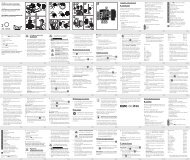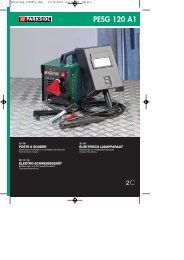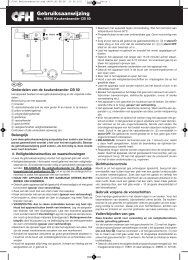FKS 2200 B1 - Lidl Service Website
FKS 2200 B1 - Lidl Service Website
FKS 2200 B1 - Lidl Service Website
Create successful ePaper yourself
Turn your PDF publications into a flip-book with our unique Google optimized e-Paper software.
GB IE<br />
16<br />
3. Slide the saw chain (5) into the<br />
bar guide groove. To mount the<br />
guide bar (4), raise it to an angle<br />
of approx. 45 degrees. This will<br />
make it easier to replace the saw<br />
chain (5) onto the sprocket (23).<br />
It is normal that the saw chain<br />
(5) is slack. Sagging in the chain<br />
is normal.<br />
4. Pre-tighten the chain (5) by<br />
turning the tensioning plate (23)<br />
clockwise.<br />
5. Position the sprocket chain<br />
wheel covering (16). First place<br />
the tab (25)on the cover into the<br />
corresponding notch on the plate<br />
(16). Only lightly tighten the fastening<br />
bolt (14), as you will still<br />
have to tension the saw.<br />
Refer to the start-up section on<br />
how to tension the saw chain.<br />
Sawing techniques<br />
General<br />
• You have better control when you saw<br />
with the bottom side of the chain bar<br />
(with pulling saw chain) and not to<br />
with the top side of the chain bar (with<br />
pushing saw chain).<br />
• The saw chain must not contact either<br />
the ground or another object during<br />
sawing through or after sawing completion.<br />
• Make sure that the saw chain does not<br />
become jammed in the wood. Do not<br />
let the tree trunk break or split off.<br />
• Consider also the precautions against<br />
spring-back (see notes on safety).<br />
Bucking<br />
If the saw chain jams, you do not<br />
attempt to pull out the electric<br />
chainsaw using power. There is<br />
a danger of injury here. Switch<br />
off the motor and use a lever or<br />
wedge to free the electric chainsaw.<br />
This refers to sawing up a felled tree trunk<br />
into smaller sections.<br />
• Ensure that the saw chain does not<br />
come in contact with the ground during<br />
sawing.<br />
• Make sure you have a secure stance<br />
and, in the case of sloping ground,<br />
stand above the log.<br />
K<br />
L<br />
1. Log is lying on the ground:<br />
Saw through the log completely<br />
from above and ensure at the<br />
end of the cut not to contact the<br />
ground.<br />
If you can turn the tree trunk, saw<br />
two-thirds of the way through it.<br />
Then turn the trunk around and<br />
saw the rest of the way through<br />
from above.<br />
2. Log is supported at one end:<br />
Start sawing from the bottom and<br />
work your way up (with the upper<br />
edge of the bar) a third of the way<br />
into the diameter of the trunk to<br />
prevent splitting. Then saw from<br />
the top downwards with the lower<br />
edge of the bar towards the first<br />
cut to prevent the bar from becoming<br />
jammed in the wood.
















